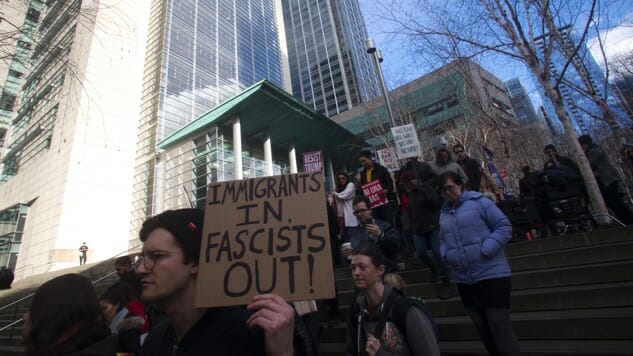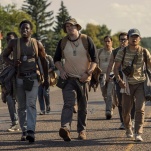Life as a Newfound Campaigner: Helping DACA Students Stay Safe
Photo by Karen Ducey
To campaign for something means following six steps:
1. Investigate.
2. Negotiate.
3. Educate.
4. Demonstrate.
5. Direct Action.
6.Parallel institutions.
Over the past few months, I’ve been meeting with a group that has at times discussed with community members what actions could be taken to protect DACA students. As a result, we went from appearing in a local newspaper in pursuit of a “sanctuary campus” to having detailed information published on the website of the university in question that details where ICE can go on campus, what it can and can’t do, and what pursuing FERPA can do for you as a student. As I write this, I am wondering about what steps the group can pursue next.
This is partly down to the fact that I’ve recently come from a workshop I had a small part in bringing to the basement of a local coffee shop. An experienced organizer and activist came to the tiny city where I live in order to help people start to organize politically who might not have had the introductory tools presented to them before.
Six people showed up.
One of the six—a middle-age woman—voiced a concern I’ve heard more than once since November. “I just want to do something,” she said, and expressed a feeling of overwhelmed grimness at just how much there was to be done.
Here is the answer I wish I gave her, using my participation in some work regarding DACA students as an example:
1. Investigate
Be aware of every chess piece on the board. Who’s out there? What do they have to offer? How is the scenario playing out in different cities across the country? (And not just at the level of headlines: what’s the rhythm of the place when you slow your focus down and start to look at it? Who’s the potential ally in waiting?)
Research dug up a lot for us, most of which is omitted here, but one thing it quickly made apparent was that asking for a ‘sanctuary city’ was a little bit besides the point. Ted Wheeler had strongly suggested that Portland, Oregon was going to be a sanctuary city—and then ICE showed up in Portland, anyway.
So after distributing flyers at an event featuring a former high-level government official and notifying a personal contact at the press that something related to sanctuary cities was going to happen at this event, we decided to change tack. We also took note of the fact that a representative of the university partially responded by citing the fact that they took guidance from the Attorney General’s office. (As a writer who thrives on detail, I’m aware that vagueness here makes it look like this is a hostage note, but it’s required.)
We also heard that the last time students took direct action against the school’s President, they were met with a surprisingly harsh response — and the students didn’t get what they were asking for either.
2. Negotiate
We also made contact with someone who would put us in touch with DACA students. Together, we had long, multi-hour conversations on what students might want.
What was the space between a college saying it cares about its students pointing towards the Attorney General, and what could a collection of students, professors, and members from the community come to the table with? What contingencies could we expect? How could we reasonably meet them? We’d already jumped ahead to ‘educate’ when we’d distributed hundreds of flyers to a crowd that informed them the university wasn’t necessarily enforcing its own stated policy when it came to providing protection for students, but how well had we educated the public? What was our best judge of that? Were they—for instance—aware of the 287(g) program?
A group of professors, students, and others met with the college president and his team to discuss the matter. We submitted a list of questions and general meeting advice to our DACA contact. We made a point of grounding our questions in specific relationships and in applicable use. They answered and promised to make some of those answers available in a public FAQ. They did.
So now what? Was that a victory of a certain kind? A first step?
How can we continue to make sure that we’re doing our part to responsibly ensure the protection of DACA students?
I would answer with this: don’t confuse shifting events with sufficient action, a job finished and done. Just because 292 “law professors and scholars in the areas of immigration, migration, constitutional, administrative, and international law” signed a letter suggesting that an Executive Order against Sanctuary Cities is unconstitutional doesn’t mean that the work is done. A local city council might not be aware of this development and, even if it was, there’s no guarantee that development would reflect the specificity of life in the town or what the residents of the town might want, which is why you have to show up.
Individualism, quick results, feeling like you’re part of the action—or, better yet, feeling like you’re part of the story, feeling wary of those who seem to be a little too much like they’re part of a club or part of a clique—none of these things will help you if you’re trying to help DACA students who have every right to be here stay in the United States. The same could very well hold true if you’re campaigning to save the National Endowment for the Arts, Planned Parenthood, or something else altogether. You’re going to have to work towards feeling comfortable with sacrificing some aspect of this in order to get the job done.







































